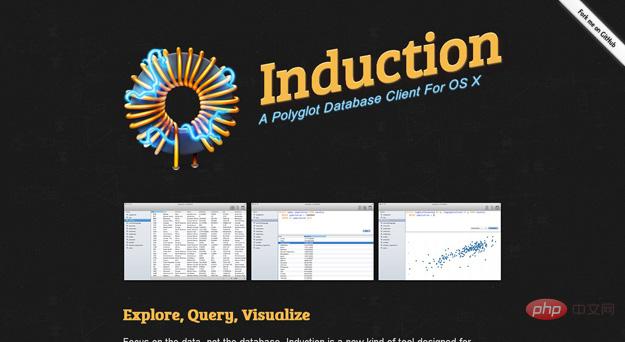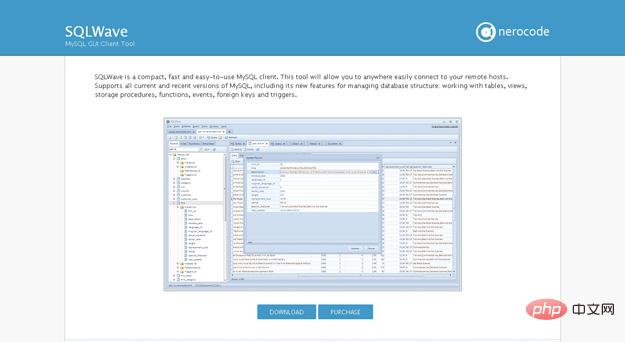What are the mysql management tools?
mysql management tools include: 1. Induction, an open source management tool for understanding data relationships; 2. Pinba, a MySQL storage engine tool; 3. DB Ninja, a Web-based MySQL database management and development application; 4. DBManager, a powerful data management application; 5. MyWebSQL, which can manage Web-based MySQL databases; 6. SQLyog, which can connect to any number of MySQL servers at the same time.

The operating environment of this tutorial: windows7 system, mysql8 version, Dell G3 computer.
For developers, the mysql management tool can be said to be indispensable. It can help developers support a variety of databases including PostgreSQL, MySQL, Redis, MongoDB, etc. in many aspects; it also It can provide a variety of functions including triggers, events, views, data backup, object structures, etc.
This article helps you sort out 15 excellent MySQL management tools and application software. You can choose one from them to help you complete your work easily and quickly.
1. Induction

2. Pinba
 ##Pinba is a MySQL storage engine whose function is PHP real-time monitoring and the MySQL read-only interface to the data server. It organizes and processes data sent via UDP, and displays statistics on multiple PHP processes in the form of simple, readable reports. To obtain the next generation of more complex reports and statistics, Pinba provides a read-only interface to raw data.
##Pinba is a MySQL storage engine whose function is PHP real-time monitoring and the MySQL read-only interface to the data server. It organizes and processes data sent via UDP, and displays statistics on multiple PHP processes in the form of simple, readable reports. To obtain the next generation of more complex reports and statistics, Pinba provides a read-only interface to raw data.
3. DB Ninja
##DbNinja is a web-based MySQL database management and development application , ideal for remote access to hosted servers. DbNinja supports the latest features including triggers, events, views, stored procedures and foreign keys. In addition, it can import and backup data, MySQL object structure, manage users, etc. DbNinj's user interface is not only beautiful but also fully functional and can run safely in any browser and operating system. 
##DBManager is a powerful data management application. It supports some new features such as MySQL, PostgreSQL, Interbase/Firebird, SQLite, DBF tables, MSAccess, MSSQL server, Sybase, Oracle and ODBC database engines. Currently, DBManager has two versions: personal and enterprise, and users can choose by themselves.

5. Dbeaver
##DBeaver is a database management application that can be used in a variety of Different engines, including MySQL, MSSQL, Oracle, SQLite, Sybase and Firebird, etc., and the most important thing is that it is free. DBeaver is written in Java and is suitable for all current mainstream operating systems. It can handle many tasks, including metadata editing (tables, columns, keys, indexes), custom SQL execution, user management, multiple connections, etc.

##SQLWave is a simple An easy-to-use MySQL client through which users can easily connect to remote hosts. SqlWave supports all the latest versions of MySQL, and can be used to manage all the latest features of the database structure, including worksheets, views, stored procedures, functions, events, foreign keys and triggers. 
7. MyWebSQL
##MyWebSQL is mainly used for management Web-based MySQL database. Using this tool, users can complete some simple operations without switching web pages. If you are operating the desktop, you only need to log in to the database to manage your database.
8, Navicat
9、SQLyog
##SQLyog as a MySQL management tool The function is very powerful, it combines the features of MySQL workbench, php MyAdmin and other MySQL front-end and MySQL GUI tools. The application can connect to any number of MySQL servers simultaneously for both testing and production. All processes only require logging into the MySQL root to collect data, and users do not need to be installed on the MySQL server.
10. Sequel Pro
##Sequel Pro is a fast and easy-to-use database based on MySQL database. Mac database management application. Users can directly access MySQL databases on local and remote servers through Sequel Pro. However, the latest version of Sequel Pro starts to add full-screen support built-in.

12. MyDB Studio

#SQL Lite Manager is an open source web-based application for managing serverless, zero-configuration SQL Lite databases. The program is written in PHP. In addition to recording and applying every step of the operation on the table, it can also control multiple databases. SQL Lite Manager can be used to query data, convert MySQL queries into compatible SQL Lite databases, and create and edit triggers. SQL Lite Manager has multiple skin options and is a multi-language resource with ready-made language files.
14. Database Master
##Database Master is a Modern, powerful, intuitive and easy-to-use database management program. It works with databases such as MongoDB, MySQL, PostgreSQL, FireBird, SQL Lite, MS SQL Server, SQL Azure, Oracle, IBM DB2, IBM Informix, Netezza, Ingres, and EffiProz with a consistent and modern interface. Database Master simplifies managing, querying, editing, visualizing, designing and reporting on database systems. Users can connect to any database system through ODBC and OleDB, and can also access MS Access, MS FoxPro Database, Dbase and XML files.
15. Chive
##Chive is built by PHP Cheng is a web-based open source MySQL management application. The app has a built-in editor for quick browsing when running complex queries or an easy-to-use interface.
【Related recommendations: mysql video tutorial】
The above is the detailed content of What are the mysql management tools?. For more information, please follow other related articles on the PHP Chinese website!

Hot AI Tools

Undresser.AI Undress
AI-powered app for creating realistic nude photos

AI Clothes Remover
Online AI tool for removing clothes from photos.

Undress AI Tool
Undress images for free

Clothoff.io
AI clothes remover

AI Hentai Generator
Generate AI Hentai for free.

Hot Article

Hot Tools

Notepad++7.3.1
Easy-to-use and free code editor

SublimeText3 Chinese version
Chinese version, very easy to use

Zend Studio 13.0.1
Powerful PHP integrated development environment

Dreamweaver CS6
Visual web development tools

SublimeText3 Mac version
God-level code editing software (SublimeText3)

Hot Topics
 1378
1378
 52
52
 MySQL: The Ease of Data Management for Beginners
Apr 09, 2025 am 12:07 AM
MySQL: The Ease of Data Management for Beginners
Apr 09, 2025 am 12:07 AM
MySQL is suitable for beginners because it is simple to install, powerful and easy to manage data. 1. Simple installation and configuration, suitable for a variety of operating systems. 2. Support basic operations such as creating databases and tables, inserting, querying, updating and deleting data. 3. Provide advanced functions such as JOIN operations and subqueries. 4. Performance can be improved through indexing, query optimization and table partitioning. 5. Support backup, recovery and security measures to ensure data security and consistency.
 How to open phpmyadmin
Apr 10, 2025 pm 10:51 PM
How to open phpmyadmin
Apr 10, 2025 pm 10:51 PM
You can open phpMyAdmin through the following steps: 1. Log in to the website control panel; 2. Find and click the phpMyAdmin icon; 3. Enter MySQL credentials; 4. Click "Login".
 MySQL: Simple Concepts for Easy Learning
Apr 10, 2025 am 09:29 AM
MySQL: Simple Concepts for Easy Learning
Apr 10, 2025 am 09:29 AM
MySQL is an open source relational database management system. 1) Create database and tables: Use the CREATEDATABASE and CREATETABLE commands. 2) Basic operations: INSERT, UPDATE, DELETE and SELECT. 3) Advanced operations: JOIN, subquery and transaction processing. 4) Debugging skills: Check syntax, data type and permissions. 5) Optimization suggestions: Use indexes, avoid SELECT* and use transactions.
 How to create navicat premium
Apr 09, 2025 am 07:09 AM
How to create navicat premium
Apr 09, 2025 am 07:09 AM
Create a database using Navicat Premium: Connect to the database server and enter the connection parameters. Right-click on the server and select Create Database. Enter the name of the new database and the specified character set and collation. Connect to the new database and create the table in the Object Browser. Right-click on the table and select Insert Data to insert the data.
 MySQL and SQL: Essential Skills for Developers
Apr 10, 2025 am 09:30 AM
MySQL and SQL: Essential Skills for Developers
Apr 10, 2025 am 09:30 AM
MySQL and SQL are essential skills for developers. 1.MySQL is an open source relational database management system, and SQL is the standard language used to manage and operate databases. 2.MySQL supports multiple storage engines through efficient data storage and retrieval functions, and SQL completes complex data operations through simple statements. 3. Examples of usage include basic queries and advanced queries, such as filtering and sorting by condition. 4. Common errors include syntax errors and performance issues, which can be optimized by checking SQL statements and using EXPLAIN commands. 5. Performance optimization techniques include using indexes, avoiding full table scanning, optimizing JOIN operations and improving code readability.
 How to create a new connection to mysql in navicat
Apr 09, 2025 am 07:21 AM
How to create a new connection to mysql in navicat
Apr 09, 2025 am 07:21 AM
You can create a new MySQL connection in Navicat by following the steps: Open the application and select New Connection (Ctrl N). Select "MySQL" as the connection type. Enter the hostname/IP address, port, username, and password. (Optional) Configure advanced options. Save the connection and enter the connection name.
 How to recover data after SQL deletes rows
Apr 09, 2025 pm 12:21 PM
How to recover data after SQL deletes rows
Apr 09, 2025 pm 12:21 PM
Recovering deleted rows directly from the database is usually impossible unless there is a backup or transaction rollback mechanism. Key point: Transaction rollback: Execute ROLLBACK before the transaction is committed to recover data. Backup: Regular backup of the database can be used to quickly restore data. Database snapshot: You can create a read-only copy of the database and restore the data after the data is deleted accidentally. Use DELETE statement with caution: Check the conditions carefully to avoid accidentally deleting data. Use the WHERE clause: explicitly specify the data to be deleted. Use the test environment: Test before performing a DELETE operation.
 How to execute sql in navicat
Apr 08, 2025 pm 11:42 PM
How to execute sql in navicat
Apr 08, 2025 pm 11:42 PM
Steps to perform SQL in Navicat: Connect to the database. Create a SQL Editor window. Write SQL queries or scripts. Click the Run button to execute a query or script. View the results (if the query is executed).









